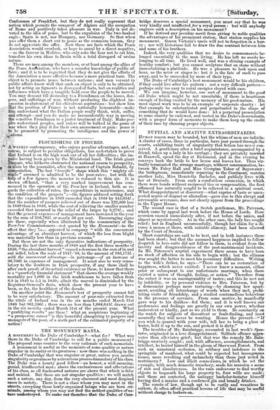FLOURISHING IN FIGURES.
A WEEKLY contemporary, who enjoys peculier advantages, and, of course, is subject to peculiar obligations has undertaken to prove that Ireland is on the high road out of all her difficulties ; the im- pulse having been given by the Ministerial hand. The Irish giant Despair, who hitherto obstructed the national course to prosperity, is slain by the journalist, after the manner of Captain Bo by computation. The last " terrtyrc " shape which this "mighty ob- stacle" assumed is admitted to be the poor-rates; but with help of a few figures the monster is reduced to thin air. It is shown off-hand, "that a very marked improvement has com- menced in the operation of the Poor-law in Ireland, both as re- gards the collection of rates, the expenditure in maintenance, and the condition of the paupers " ;—the figures adduced setting forth that the expenditure in 1849 exceeded that in 1848 by 445,0541.; that the number of paupers relieved out of doors was 222,560 less in 1849 than in 1848, while the cost of relieving the smaller number exceeded that incurred in the relief of the larger by 8,2781.; and that the general expenses of management have increased in the year by the sum of 216,782/. or nearly 50 per cent. Encouraging signs are these, especially when illustrated by the commentary of the Poor-Iaw Commissioners—not quoted by the Economist—ta the tiled that they ha, appeared in company "with the concurrent advantage of an abundant harvest, of which the loss from blight was materially less than in previous seasons."
But these are not the only figurative indications of prosperity. During the last three months of 1849. and the first three months of 1850, "the abundant harvest" caused a decrease in the cost of in and out relief, below the scale of 1847-'48, to the amount of 185,1751.; with the concurrent advantage—in, patronage—of an increase of 36,7041. in expenses of management. It must also be very conso- latory to the doubters in Irish prosperity, if any there shall be after such proofs of its actual existence as these, to know that there is a "quarterly financial statement" that shows the average weekly mortality per 1,000 in the Irish workhouses to have fallen from 8.9 in 1849 to 5.5 in 1850; albeit the marvel is diminished by the Registrar-General's facts, which show the present year to have been, so far, the healthiest of the decade.
On another point the Economist's test of prosperity cannot fail to be very satisfactory. The amount of poor-rate extracted from the vitals of Ireland was in the six months ended March 31st 1848. but 961,3561.; there was no less than 1,084,645/. drawn out in the six months ended March 31st of the present year. What "gratifying results" are these ! what an auspicious beginning of "a prosperous career" is this bountiful almsgiving to paupers and managers of the poor, of a sixth part of the estimated property of a nation !


























 Previous page
Previous page